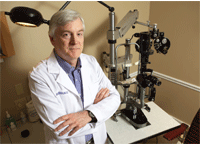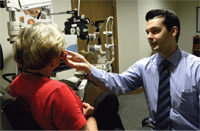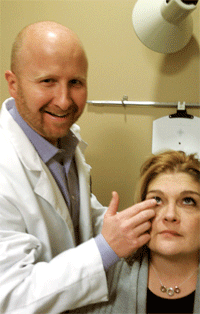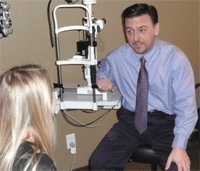Contact lenses are a safe and viable choice for vision correction, allowing you to tailor each fit to your patients’ individual lifestyle demands. While patients have enjoyed the quality-of-life benefits contact lenses provide, many experience a decrease in acuity as presbyopia begins to impair their ability to function when performing near tasks. These patients may get discouraged and feel as though they have to trade in their lenses for reading glasses. On the flip side are those patients who have never required vision correction and are suddenly reaching for readers to be able to decipher the buttons on their cell phones and keyboards. So, how do you handle your patients’ mid-life crisis, one that stems from the decline of their near vision?
Whether the presbyope in your chair is someone who has successfully worn contact lenses for years or someone who’s never needed vision correction, this patient has come to you during a transitional time, and what you say and do during the initial visit can have an impact on that patient’s chances of multifocal lens wear success.
While there are a multitude of presbyopic lens options on the market, one lens modality does not fit all, and certain lenses can better serve certain patients. A thorough history and lifestyle assessment are essential in pairing a lens with a patient. Additionally, there are many other factors to consider when fitting presbyopic lenses: Should you stick with monovision or opt for multifocals? Which patients would benefit from translating vs. simultaneous designs? And, what about presbyopes with astigmatism? To help navigate the maze of multifocal contact lenses, we’ve asked Joseph Shovlin O.D., clinical editor of Review of Cornea and Contact Lenses (RCCL) and other regular RCCL contributors to share experiences with their “go-to” presbyopic lenses.
Joseph Shovlin, O.D., Clinical Editor, RCCL.

Most patients who present with presbyopia seek independence from their reading glasses, and the majority of them are currently using contact lenses. Some report a sudden difficulty seeing things they could see last month, while others struggle for months until they arrive for their annual examination—but all seek relief from their near frustrations. For these patients,
I will often reach for an aspheric multifocal hydrogel or silicone hydrogel design.
Some patients are essentially emmmetropic, but as presbyopia sets in, they become totally annoyed that their once-perfect vision has been violated by the creeping age factor. In most cases, I will opt for either Bausch+Lomb’s or CIBA Vision’s multifocal lens and start with a low add power in order to only slightly affect distance vision. As higher add powers are needed, I’ll under-correct myopes in the non-dominant eye, and then eventually switch to the high add power (at times requiring under-correction). This approach seems to work well for a wide range of add power needs.
The balanced vision—distance and near—keeps most patients happy over a long period of time. Occasionally, when patients have difficulty at near (generally those who require more reading time or have to sustain long periods of reading), I will try the Proclear N (CooperVision) for the non-dominant eye. So, mixing and matching add powers or lens type is generally the norm for me.
John Rinehart, O.D.
For the presybopic patients that require gas-permeable lenses, my first choice is most often an aspheric lens design. Aspheric lenses tend to provide superior vision at intermediate/computer distances and distance. For those requiring a high add, these lenses may not provide ideal near acuity at normal reading distances, but they are ideal for many of my patients.

Throughout my 36 years in practice, I have tried many multifocal lenses with varying degrees of success. My greatest frustration was that I did not know all of the parameters of the lenses, so when it came time to change the fit or power of the lens, I was not always able to predict exactly how these changes would affect the lens fitting characteristics. I also did not like that many aspheric lenses were fit with significant apical clearance. As you know, this can cause the cornea to be reshaped and thus interfere with patients’ spectacle acuity.
My dissatisfaction with the fit of these lenses led me to begin designing my own aspheric multifocal lenses. Aspheric lenses produce add power because the lens gradually becomes flatter in the periphery, providing the potential add for the lens. This same flattening requires the lens to have an apical radius (measured as the base curve) that is steeper than the flat keratometer reading. If the apical radius is not steeper than the keratometer reading, the lens fit will be extremely flat. By coordinating the amount of eccentricity with the steepness of the apical radius, you ensure that the resulting lens will fit well (i.e., slight apical clearance with light touch in the horizontal meridian, which will allow the lens to have movement in the vertical meridian).
When fitting these lenses, the first thing I must determine is how much add the patient needs and how much eccentricity will be needed to achieve this add power. For low add requirements (+1.25D to 1.50D), I will choose a 0.8 e (e = eccentricity) and select an apical radius that is 2.00D steeper than the flatter keratometer reading. For each 0.1 increase in the e value, the base curve is steepened by 0.50D. This relationship keeps the sagittal depth of the lenses the same and as a result, there is no change in the lens fitting characteristics when the add power is increased.
Mile Brujic, O.D., and Jason Miller, O.D., M.B.A.
We have a number of contact lens options for our presbyopic patients to offer them customized solutions for their lifestyle needs. Gaining an appreciation for your patients’ lifestyle (including work, hobbies, sports and any other activities that they regularly participate in) is a critical component of a successful multifocal contact lens fit.

• Part-time CL Wearing Presbyope. Presbyopes who wish to wear contact lenses on a part-time basis often are using them for very specific reasons (i.e., playing sports or engaging in other physical activities, going out without being dependent on their glasses, etc.). In these situations, a daily disposable contact lens works well because each time patients wear their lenses, they place a fresh one on the eye. These patients often prefer single vision distance prescription lenses because they are typically unwilling to sacrifice much distance quality at all. Sometimes these patients function well with a slightly under-corrected non-dominant eye; this helps preserve their distance vision while providing better near visual function.
Focus Dailies Progressives (CIBA Vision), which are the only soft multifocal contact lenses that are available in a daily disposable modality, is a convenient alternative for part-time wearers. A modified monovision approach, where the dominant eye is fit with a single vision lens and the non-dominant eye is fit with a multifocal lens, can be advantageous for patients in this category. This again optimizes their distance vision while giving them the ability to see up close.

• Full-time CL Wearing Presbyopes. These patients are typically looking to retain functionality with their contact lenses without being dependent on reading glasses to see things at near. Additionally they do not want to give up contact lens wear in exchange for multifocal spectacle lens wear.
With the full-time lens wearing presbyope, eye care practitioners need to provide an individualized approach. When we do this well, we have the ability to maximize our presbyopic patients’ wearing experience and minimize the chances of them dropping out of contact lenses.
The Proclear multifocal (CooperVision) has a wide variety of fitting options and fitting strategies due to its design. Dominant (distance center, near surround) and non-dominant (near center, distance surround) designs offer flexibility in the prescribing of these lenses. In our experience, they tend to work well with presbyopes who may have dry eye issues.
Another excellent option, which comes in an array of add powers, is the Air Optix Multifocal (CIBA Vision), the newest addition in the silicone hydrogel presbyopic lens category. It provides an aspheric design with a near center and is available in a low, medium and high add for the various levels of presbyopia.
The Acuvue Oasys line of contact lenses is highly utilized for single vision use and for those with astigmatism. The transition into presbyopia has become slightly easier with the Acuvue Oasys for Presbyopia (Vistakon). This lens offers the same comfort as its single vision predecessor with the added bonus of providing both distance and near correction.
We’ve also had success with the PureVision multifocal lens (Bausch+Lomb), which is produced with a near center and aspheric optics. The simplicity of the lenses having two add powers (low and high) make this lens relatively easy to fit. As with the other silicone hydrogel multifocal lenses, this one is approved for extended wear.
Jason Jedlicka, O.D.
Depending on the needs of the individual patient, I tend to have my favorite lenses within each lens design subcategory. For back surface aspheric designs, I have enjoyed working with the Lifestyle GP (Lifestyle GP Company) for many years. This lens is easy to use, has customized add sizes, and the multiaspheric back surface is less prone to corneal molding than others I have used.

For front surface aspheric designs, I have grown to like the Renovation multifocal. This lens is also easy to fit and is comfortable to wear. It has a thin profile, fits most corneas well, has available add powers up to +3.50D and generally centers well.
In the translating design category, I really like working with the Bi-expert (Blanchard) lens. I have never been big on translating design lenses, but have had wonderful success in the past two years with the Bi-expert. One example of this is a patient that I fit about a year ago. He had been using single vision distance GPs with reading glasses over them. As a magazine editor in his 60s, he did a lot of near work but was not using a computer as much as you might expect. He wanted to have better reading vision, but his history of retinal detachment with scleral buckle and cataract surgery in that eye left him with high levels of anisometropia and slightly reduced best-corrected vision. This is why I wanted to direct him away from an aspheric design. With the Bi-expert, he was able to achieve very good distance and near vision and had no concerns with comfort at all. I have found the Bi-expert to be far more comfortable than expected for a translating bifocal design.
Seize the Opportunity
There is tremendous opportunity in offering multifocal lenses to your patients, as many are not even aware that these lenses are available and that they may be candidates.1 These patients resign themselves to wearing reading glasses or, worse yet, stretching their arms out and squinting while reading a newspaper.
But keep in mind—the early presbyope will likely require a certain degree of “hand-holding” during the initial consultation. When introducing the idea of multifocal lenses, you may want to choose your words wisely. Rather than using questionable adjectives such as “compromising,” describe multifocal lenses as “striking a balance” between distance and near.2
Aging gracefully is no easy feat, and while you can’t repair your patients’ stubborn grays or crow’s feet, you have the ability to help them maintain functional near vision without having to depend on spectacles. Just remember the advice of our expert panel, and you’ll have no trouble customizing your multifocal contact lens fits with each patient’s needs in mind.
1. Contact lens council. New survey finds more education on contact lenses and lens care will help consumers see 20/20. Available at:
www.sys-con.com/node/416498. (Accessed November 2010).
2. Brujic M, Miller J. Presbyopic Fits, Part One: Setting the Stage. RCCL. 2008 Sep;145(6):14-5.

